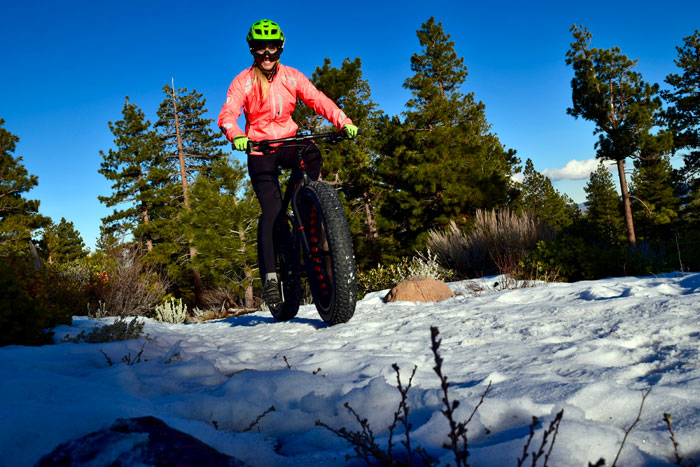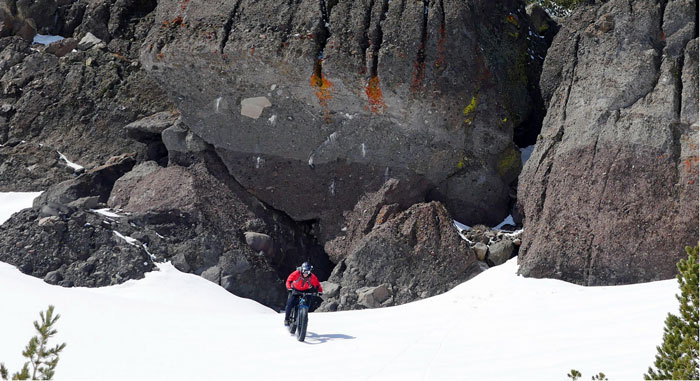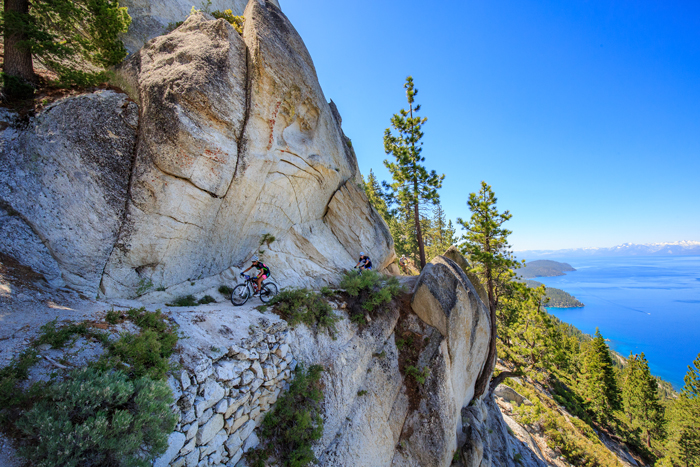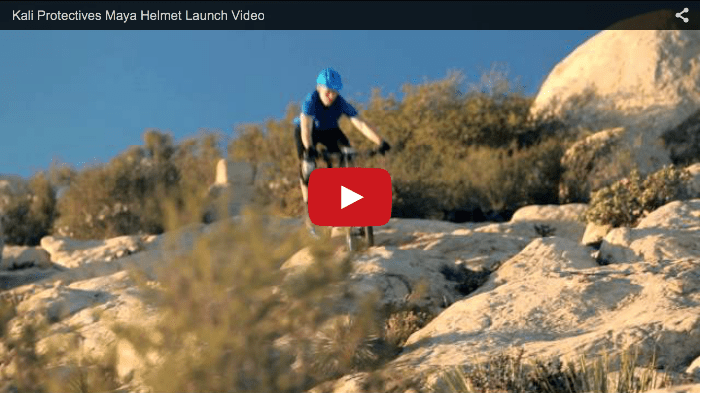- California Enduro Series Announces 2024 Schedule - 11/19/2023
- ASHLAND MOUNTAIN CHALLENGE 2023 – CES RACE REPORT - 10/04/2023
- China Peak Enduro 2023 – CES Race Report - 09/04/2023
Fat bikes open up a whole new world of two-wheeled adventures
By Dave Zook

Main image: First Tracks Productions founder Anthony Cupaiuolo and his dog Emmie are both pinned on a Tahoe descent (First Tracks Productions).
Fat bikes are all the buzz. Those absurdly wide tires — sometimes over five inches of knobby, under-inflated width — does anyone know exactly what makes them so great? Regardless they are certainly hitting mass appeal as this variation on a traditional mountain bike has been growing steadily around California and the US for the last decade.
More brands than ever are manufacturing them, giving riders options formerly reserved for the MTB or road riding crowd. Full-suspension rides are offered for the most cushy of experiences and even fancy components like carbon wheel sets can lighten the load, depending on your riding style — and the size of your wallet.
Many riders become believers due to the bike’s ability to make some terrain more accessible. The traction is the key here and they “float” over most terrain aided by a low PSI, usually around 10 to 15, according to gearjunkie.com. Although they are known most for their snow functionality, they are making headway on sand, mud, and rocky landscapes as well.
“I believe it’s great because you feel like a kid again. There is something about the ‘marshmallow’ ride and the ability to ride terrain with ease that a normal mountain bike struggles with,” said Matt Reynolds, a Tahoe rider who opts for the fat bike year-round. “It feels like cheating. I also call fat biking ‘biking for dummies’ because it’s hard to screw up.”
Access and opportunities are growing as well. Grand Targhee in Wyoming was the first ski resort to allow fat biking on its Nordic trail system in 2011, and many ski areas and Nordic areas have followed suit. In January Spirit Mountain in Minnesota became the first ski area to allow fat bikers to load the lifts for downhill trails, and Crested Butte also started allowing fat bikers on their lifts recently.
In addition, events such as the newly formed Global Fat Bike Summit in Jackson, WY is another indicator these bikes are gaining momentum, and an article in Outside Online even cited the sport as one of the fastest growing winter sports in the country.
This progress has gotten riders excited to take advantage of the bikes’ utilitarian advantages and push their riding into new and remote locations, where almost no terrain is considered out of bounds. From exploration in the Eastern Sierra to singletrack trails around Tahoe, riders are finding a way to stay on their bikes no matter what the weather is doing.
Flats to the Mountains
Fat biking’s origin and subsequent growth is largely credited to places like the Midwest where very cold winters and relatively flat terrain created excellent conditions for grooming trails and creating the hardpack conditions that fat bikers find ideal.
But out west, with steeper gradients and — ideally — a deep snowpack, riders are pushing into the backcountry. Anthony Cupaiuolo, an avid fatbiker and founder of First Tracks Productions (see sidebar), said he enjoys riding in a popular snowmobile zone near Kirkwood in South Lake Tahoe, because “snowmobilers pack the road down so that makes it really easy to ride into. And once you’re out there the zone opens up and you’re above treeline.”
Riding through fresh powder still isn’t within range even for the fattest of tires. Snow needs to be somewhat consolidated — meaning packed down powder that allows those big tires to gain traction where a traditional narrower mountain bike tire would slip and slide. Therefore cold temps combined with packed snow create the ideal fat bike conditions.
Blessing in Disguise
The last four winters were unkind to the powder skiing crowd, but the drought actually created ideal conditions for fat biking exploration, and for pushing the limits of what the bikes can do. The snow was shallow and firm throughout much of the winter, allowing riders to access areas that are normally buried under feet of snow. Cupaiuolo and his crew found themselves exploring the Eastern Sierra near Yosemite, discovering zones that would be inaccessible most years due to snow, but that hold limitless potential with their vast peaks.
“We went down there in February last year to the eastern side of Yosemite, and went up Tioga Pass and didn’t hit snow until around 8500,” said Cupaiuolo. “A normal winter that would have been impossible, but with what we had to deal with last year it was necessary to get up to the snow.”
Because Why Not?
Some forms of fat biking have been around since the 90s, with homemade experimentation leading to some funky and intriguing results. Bike manufacturer Surly brought the first fatbike to the market in 2004, and since then a steady stream of manufacturers — including some that were originally critics — have followed suit.
The main complaint is that fat biking is perhaps a fad that will dissipate as the buzz dies down. After all, they are heavier and a bit more cumbersome than traditional mountain bikes. Plus they are pretty expensive (an entry level fat bike starts at around $1,500 and goes up from there).
But enthusiasts are having none of it, and are pumped to see the scene ramping up, while being totally fine with the idea that the bikes aren’t for everyone.
“A fat bike will never be for me a year-round bike, but there’s lots of things that it’s just super fun for. Long stretches in the summer when we don’t get any rain and I’ll take my fat bike out on the singletrack here because there’s improved traction when it’s really sandy and loose,” said Cupaiuolo.
But as with many sports, hobbies, recreational activities, passions – or whatever may be the label – it’s a way to have a hell of a lot of fun.
“You’ll be about five to ten percent slower on a fat bike than your friends on normal mountain bikes, but you don’t care and you’ll never wipe the smile from your face. You just need to get stronger,” enthuses Reynolds.
Fuji Bikes pro rider Lauren Gregg adds, “I love how a my fat bike makes me feel like I can go anywhere and there is no terrain I can’t ride. The fat tires give me access to anywhere I want to ride in the winter and riding descents on the snow really feels like your’re flying!”
Off the Beaten Path
First Tracks Productions, a South Lake Tahoe-based film production company, has been working on – and very nearly completed – the first full-length fat bike movie called Off the Beaten Path due to be released soon (check firsttracksproductions.com for updates). Head cheese at First Tracks, Anthony Cupaiuolo, gives us his take on fat biking.
ASJ: Some people think fat biking is a fad. What’s your take on that?
AC: If someone thinks it’s a fad, that’s cool, that’s fine, it doesn’t have to be for them, it’s not for everybody. I think if someone has the opportunity to try it, and it’s the type of situation where it makes sense to try it I think you’ll dig it, but I’m not a super advocate saying everyone needs to get a fatbike and make it their daily rider. There’s certain days where if I didn’t have a fat bike I’d be sitting on the couch and that alone makes it worth it.
ASJ: What interesting and creative terrain are people getting into?
AC: We found that for ourselves we were using the bikes to do some different things. We had one segment where we used the bikes to get to ski and snowboard spots. Where access was pretty much shot for skinning because the whole approach was pretty much melted with mud and puddles and ice.
The fat bikes ended up being the perfect approach tool. You get into a zone and get into the bottom of the bowl or something, park the bikes, put the skins on and go up and do a couple laps. That was really cool because it was something I could see myself doing this spring for fun, totally unrelated to filming.
















